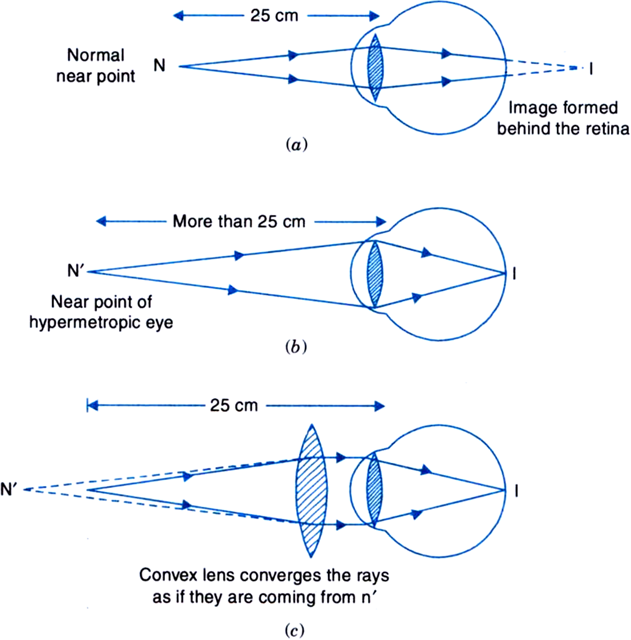Metals and Non-metals
(a) What is hypermetropia?
(b) What are the two causes of this defect of vision?
(c) How can this defect of the eye be corrected? Illustrate your answer by drawing ray diagram to show the formation of image by (i) a hypermetropic eye,(ii) a hypermetropic eye corrected with a suitable lens.
Hypermetropia is also known as long-sightedness. In this defect, a person can see the distant objects clearly but cannot see the nearby objects clearly.
Cause of hypermetropia:
This defect arises due to either of the following two reasons:
(i) The eyeball becomes too small along its axis so that the distance between the eyelens and the retina is reduced.
(ii) The focal length of the eyelens becomes too large resulting in the low converging power of the eyelens.
As a result of the above mentioned causes, the rays coming from an object placed at 25 cm (normal near point) from the eye meet at a point behind the retina. So the object cannot be seen clearly.
Fig. Hypermetropia and its correction
The object has to be moved away from the eyes to a distance greater than 25 cm inorder to focus the rays again on the retina. Thus, the near point of the eye is not at 25 cm but it has shifted to N' at a distance greater than 25 cm from the eyes.
Correction of hypermetropia:
A hypermetropic eye is corrected using a convex lens of suitable focal length. This lens diverges the rays such that the rays coming from normal near point N appear to come from near point N' after refraction. That is a virtual image of the object placed at N is formed at N'. Then the eyelens forms a clear image at the retina, as shown in Fig. (c).
Sponsor Area
Some More Questions From Metals and Non-metals Chapter
Why do metals possess lustre?
Why are metals generally ductile and malleable?
What is meant by hardness of a substance? Name some metals which are hard.
Explain, how can we find out whether a given substance is a metal if we know its electronic configuration.
Demonstrate why some metals are used for making cooking vessels?
Illustrate that metals are good conductors of electricity. Which metals are used for this purpose?
Aluminium or copper wire required for electric circuits are coated with a rubber—like material. Why?
Why is it not possible to group metals and non-metals on the basis of their physical properties? Explain.
What are non-metals?
Mock Test Series
Sponsor Area
NCERT Book Store
NCERT Sample Papers
Sponsor Area